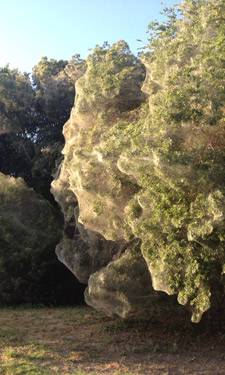 Huge communal spider webs sound like something out of a sci-fi thriller, but they’re very real, and they’re nothing to be afraid of. When Jeff Reynolds, a resident of Rowlett, Texas, happened upon a massive collection of connected spider webs in the trees at Lakeside Park South, he was initially worried, but not for the reason you might think. “I was concerned. We have tree parasites here, and since it covered entire trees, I was worried.” After alerting Rowlett Parks and Recreation authorities, Reynolds discovered that the strange sight in the trees was actually a grouping of spiders that formed one giant communal nest. Reynolds said he had never seen anything like it, explaining that he’s “had an interest in arachnology from a young age.” Dr. Roy Vogtsberger, an entomologist at Midwestern State University, suspects the spiders are of the species Tetragnatha guatemalensis, which were responsible for a similar gigantic web constructed in 2007 at Lake Tawakoni in Wills Point, Texas.
Huge communal spider webs sound like something out of a sci-fi thriller, but they’re very real, and they’re nothing to be afraid of. When Jeff Reynolds, a resident of Rowlett, Texas, happened upon a massive collection of connected spider webs in the trees at Lakeside Park South, he was initially worried, but not for the reason you might think. “I was concerned. We have tree parasites here, and since it covered entire trees, I was worried.” After alerting Rowlett Parks and Recreation authorities, Reynolds discovered that the strange sight in the trees was actually a grouping of spiders that formed one giant communal nest. Reynolds said he had never seen anything like it, explaining that he’s “had an interest in arachnology from a young age.” Dr. Roy Vogtsberger, an entomologist at Midwestern State University, suspects the spiders are of the species Tetragnatha guatemalensis, which were responsible for a similar gigantic web constructed in 2007 at Lake Tawakoni in Wills Point, Texas.
As for what caused the phenomenon, Reynolds knows that the communal web behavior only occurs when the environment is right. “When I see a large grouping of spiders, I know there’s a reason for that,” he says. “We’ve had record amounts of rainfall, resulting in standing water and more mosquitoes. The spiders eat those mosquitoes. I never looked at it as creepy or weird, because I can understand why such a thing occurred.” Reynolds believes these webs present a great educational opportunity that could reduce the public’s fear of spiders and promote a better understanding of the local environment, saying the webs could “go from an eyesore to a city resource.” But, is there any danger in these webs? Rowlett Parks and Recreation Manager, Keith Flournoy, says, “It’s not something we’re concerned about. People say, ‘the spiders are invading our park!’ They’re not in the park, they’re on the edge of the park near the water, and they’re not invading. There are no negative impacts.”
Marissa Bracamonte is an Editorial Intern for Parks & Recreation magazine.

